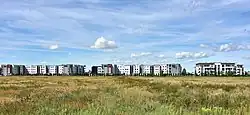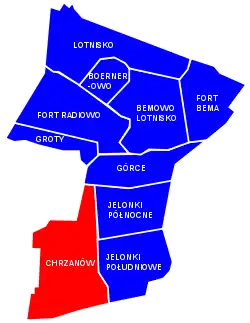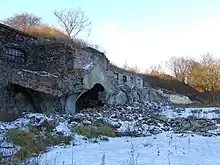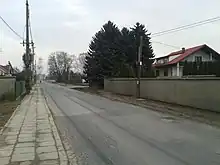Chrzanów, Warsaw
Chrzanów is a residential neighbourhood, and an area of the Municipal Information System, in the city of Warsaw, Poland, located within the district of Bemowo.[1]
Chrzanów | |
|---|---|
Neighbourhood and Municipal Information System area | |
 The apartment buildings at the Batalionów Chłopskich Street in Chrzanów, in 2018. | |
 Location of Chrzanów i within the district of Bemowo. | |
| Coordinates: 52°13′24.17″N 20°53′07.64″E | |
| Country | |
| Voivodeship | Masovian |
| City county | Warsaw |
| District | Bemowo |
| Time zone | UTC+1 (CET) |
| • Summer (DST) | UTC+2 (CEST) |
| Area code | +48 22 |
History
In 1448, Chrzanów was given the privileges of the Kulm law, by duke Bolesław IV of Warsaw, ruler of the Duchy of Warsaw, with Stanisław Chrzanowski being listed as the owner of the village. Its history was tied with the nearby village of Macierzysz. The village was inhabited by the Chrzanowski noble family since then.[2] Chrzanów was located near the modern Połczyńska Street, to the south of then villages of Górce and Groty.[3]
In 1512, the name of the village was listed as Macierzysz Mały (lit. Little Macierzysz; in contemporary orthography: Manczyrzysch Maly), in 1521, as Chrzanów inaczej w Mniejszym Macierzyszu (lit. Chrzanów also known as Smaller Macierzysz; in contemporary orthography: Chrzanow ynaczey w m[n]yeyschem Mączyrzyschu), and since 1526, listed as Chrzanowo, and later also Macierzysz-Chrzanowo.[2] Since 19th century, the village was known as Chrzanów.[3]
In 1827, Chrzanów was inhabited by 84 people, and had 17 houses. It was part of the gmina (municipality of Blizne.[4]
Around 1877, in Chrzanów, in the area of modern Okrętowa Street, 15 German settlers had established a small settlement (colony) of Nowy Chrzanów (lit. New Chrzanów).[3] Between the end of the 19th, and beginning of the 20th century, in Chrzanów was established a folwark-type settlement of Mory. In February 1913, the Warsaw Garden Association (Polish: Towarzystwo Ogrodnicze Warszawskie) had announced a contest, to design street plan of the settlement. In Mory had operated the expermental research facility, and a gardening school with a arboretum.[5][6]

Between 1883 and 1890, the Fort IV "Chrzanów" had been built near Chrzanów, as part of the series of fortifications of the Warsaw Fortress, build around Warsaw by the Russian Empire. In 1909, it was decided to decommission and demolish the fortifications of the Warsaw Fortress, due to the high costs of their maintenance, and as such the Fort V had been partially demolished in 1913, and was repurposed as a magazine. Currently the building remains as ruins.[7]
In the September 1939, during the Invasion of Poland, in the Second World War, the 360th Infantry Regiment of the Polish Armed Forces had defended its position against the invading forces of Nazi Germany, in the Fort IV.[7] The area was eventually captured. Nowy Chrzanów had been recaptured on 18 September 1939, in the offensive by the group of Polish Armed Forces under the command of Leopold Okulicki.[8] The village remained under Polish control until the capitulation of Warsaw, on 28 September 1939.[9]
Chrzanów was incorporated into the city of Warsaw on 14 May 1951, becoming a neighbourhood of the district of Wola.[10] It was part of the district until 1990, when it was replaced by the gmina (municipality) of Warsaw-Wola, and in 1994, Jelonki were incorporated into then-established gmina of Warsaw-Bemowo.[11][12][13] In 2002, gmina of Warsaw-Bemowo was disestabolished, and replaced by the district of Bemowo.[14][15]

Prior to 2005, Chrzanów was had mostly rural characteristics with, low-rise family houses, and farmlands. Beginning in 2006, the area begun attracting new investments with construction of large residential estates, of modern apartment buildings. In 2016, it was estimated that in the neighbourhood around 12 thousand apartments would be built, with the neighbourhood housing over 30,000 people.[16][17]
Current city development plan anticipate that the northern portion of the neighbourhood will be allocated for the apartment buildings, while the southern portion, for the signle-family housing.[18]
In 2018, it was decided to build two metro stations of the M2 line of the Warsaw Metro rapid transit underground system in Chrzanów. They are the Chrzanów located at the intersection of Szeligowskiej and Rayskiego Streets, and Karolin at the intersection of Sochaczewska and Połczyńska Streets, in the area of the historical settlement of Mory.[19][20] The preparation to begin the construction of the stations begun in 2022.[21] Both stations are planned to be opened in 2026.[22]
Public transportation
Chrzanów have bus connections to the rest of Warsaw. It is also located near the expressway S8 and the national road 92.[6]
In Chrzanów two metro stations of the M2 line of the Warsaw Metro rapid transit underground system are being built. They are the Chrzanów located at the intersection of Szeligowskiej and Rayskiego Streets, and Karolin at the intersection of Sochaczewska and Połczyńska Streets.[19][20][21] They area planned to be opened in 2026.[22]
References
- "Obszary MSI. Dzielnica Bemowo". zdm.waw.pl (in Polish).
- "Macierzysz-Chrzanowo". In: Tomasz Jurek, Stanisław Prinke: Słownik historyczno-geograficzny ziem polskich w średniowieczu, p. 143. (In Polish).
- Encyklopedia Warszawy. Warsaw: Polish Scientific Publishers PWN, 1994, ISBN 83-01-08836-2.
- "Chrzanów". In: Geographical Dictionary of the Kingdom of Poland. Warsaw: Kasa im. Józefa Mianowskiego. p. 650 (In Polish).
- Konkursy. In: Architekt, issue 11-12, 1912. p. 133-134, 1912. Kraków: Krakowskie Towarzystwo Techniczne. (In Polish).
- Ilona Łyżczarz (21 February 2022). "Chrzanów – mieszkania. Dlaczego warto zamieszkać w tej lokalizacji?". obido.pl (in Polish).
- Lech Królikowski: Twierdza Warszawa, Warsaw, 2002.
- J. Odziemkowski: Warszawa w wojnie obronnej 1939 roku, Warsaw: Państwowe Wydawnictwo Naukowe, 1989, p. 106, ISBN 83-01-07927-4, OCLC 69622110. (In Polish)
- "Leopold Okulicki. Biogram. 1939–1940. W walce z Niemcami". okulicki.ipn.gov.pl (in Polish). Archived from the original on 2018-01-14.
- Rozporządzenie Rady Ministrów z dnia 5 maja 1951 r. w sprawie zmiany granic miasta stołecznego Warszawy. 5 May 1951.
- Ustawa z dnia 22 marca 1990 r. o terenowych organach rządowej administracji ogólnej. In: 1990 Journal of Laws, no. 21, position 123. Warsaw. 1990.
- M.P. 1990 nr 13 poz. 100 Zarządzenie nr 31 Prezesa Rady Ministrów z dnia 5 kwietnia 1990 r. w sprawie uzyskania przez dzielnice m.st. Warszawy statusu gmin. In: Monitor Polski 1990, no. 13, position 100.
- Ustawa z dnia 25 marca 1994 r. o ustroju miasta stołecznego Warszawy. In: 1994 Journal of Laws, no. 48, position 195. Warsaw. 1994.
- Ustawa z dnia 15 marca 2002 r. o ustroju miasta stołecznego Warszawy. In: 2002 Journal of Laws, no. 41, position 361.
- Ustawa z dnia 19 lipca 2002 r. o zmianie ustawy o ustroju miasta stołecznego Warszawy. In: 2002 Journal of Laws, no. 127, position 1087.
- Michał Wojtczuk (5 January 2016). "Na Chrzanowie wyrośnie osiedle na 30 tys. osób. Bez szkoły i wody?". warszawa.wyborcza.pl (in Polish).
- "Planowanie przestrzenne na Chrzanowie". bemowiacy.waw.pl (in Polish). December 2018.
- "Miejscowy plan zagospodarowania przestrzennego Chrzanowa (Bemowo) - wyłożenie". bip.warszawa.pl (in Polish). 11 May 2018.
- "Druga linia metra za cztery lata dojedzie na Chrzanów. Na razie są tam uprawy i polne drogi [ZDJĘCIA]". warszawa.naszemiasto.pl (in Polish). 15 November 2018.
- "II linia metra". metro.waw.pl (in Polish). Archived from the original on 2021-01-16.
- Jarosław Osowski (1 February 2023). "Budowa końcówki metra na ubogo, pytania do Trzaskowskiego bez odpowiedzi. Padł tylko jeden termin". warszawa.wyborcza.pl (in Polish).
- Michał Mieszko Skorupka (1 February 2023). "Druga linia metra w Warszawie. Rafał Trzaskowski: Pasażerowie pojadą na Karolin w 2026 roku". warszawa.naszemiasto.pl (in Polish).